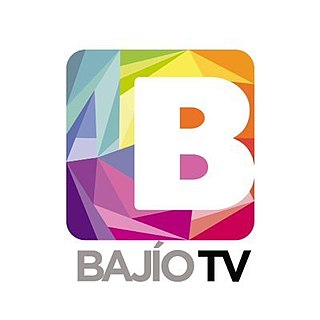XHAS-TDT is a television station in Tijuana, Baja California, Mexico, carrying Canal 66. It is owned by a Mexican company whose largest single investor is Entravision Communications, a U.S.-based broadcaster with radio and television stations in San Diego, including Univision affiliate KBNT-CD, and a similar interest in Milenio Televisión affiliate XHDTV-TDT. XHAS-TDT's transmitter is on Mount San Antonio in Tijuana.
XEWT-TDT, informally called "Tu Canal", is a Televisa owned-and-operated television station in Tijuana, Baja California, Mexico. XEWT's over-the-air signal also covers the San Diego–Tijuana region across the Mexico–United States border. XEWT's transmitter is located on Mount San Antonio in Tijuana, with a San Diego bureau on Third Avenue in Chula Vista.

XHDF-TDT, virtual channel 1, is the flagship station of the Azteca Uno television network in Mexico City, Mexico. Azteca Uno can be seen in most major cities in Mexico through TV Azteca's owned-and-operated transmitter network. XHDF provides HD programming to other transmitters and cable and satellite viewers.

Canal 6 is a network of Spanish language television stations primarily concentrated in northeastern Mexico and the southwestern United States. The system is part of Grupo Multimedios. The flagship station of Multimedios is XHAW-TDT located in Monterrey, Nuevo León. Programming features locally produced news, sports, children's shows and general mass appeal variety programming. On weekdays, the network produces around twenty hours of live daily programming, with lesser amounts during the weekends and holidays.

XHRIO-TDT was a television station in Matamoros, Tamaulipas, Mexico, which served the Rio Grande Valley area in southern Texas, United States. The station was 98% owned by Mexican-based Televisora Alco, which was 40% owned by station operator Entravision Communications; XHRIO was a sister station to Entravision's duopoly of McAllen-licensed Univision affiliate KNVO and Harlingen-licensed Fox affiliate KFXV, as well as three low-power stations, all licensed to McAllen: Class A UniMás affiliate KTFV-CD, KMBH-LD, and KCWT-CD. XHRIO-TDT maintained its basic concession-compliant studios in Matamoros, with a second studio facility across the border on North Jackson Road in McAllen housing master control and other internal operations. XHRIO-TDT's transmitter was located near El Control, Tamaulipas.

A multiplex or mux, also known as a bouquet, is a grouping of program services as interleaved data packets for broadcast over a network or modulated multiplexed medium, particularly terrestrial broadcasting. The program services are broadcast as part of one transmission and split out at the receiving end.

XHWX-TDT is a television station in Monterrey, Nuevo León and Saltillo, Coahuila, Mexico. Broadcasting on digital channel 19 in both cities, XHWX is a transmitter of the Azteca Uno network and the key station in the TV Azteca Noreste regional system, which provides regional news and sports content to Azteca's stations throughout northeastern Mexico.
XHFN-TDT is a television station in Monterrey, Nuevo León, Mexico. The station carries the Azteca 7 network and also serves as the key station of the Azteca Noreste regional network, serving the northeastern states of Mexico with regional news and programming.

XHCH-TDT is a television station in Chihuahua, Chihuahua. Broadcasting on virtual channel 1, XHCH is owned by TV Azteca and broadcasts its Azteca Uno network.

XHTVM-TDT is a television station in Mexico City, owned by Televisora del Valle de México and operated by TV Azteca. It is branded as adn40 and available over the air in much of Mexico on TV Azteca's transmitters. Programming generally consists of news and informational shows.

Azteca Uno, is a Mexican national broadcast television network owned by TV Azteca, with more than 100 transmitters across the country. Azteca Uno broadcasts on virtual channel 1. Azteca Uno programming is available in Mexico on satellite via Sky and Dish Network, as well as all Mexican cable systems, and some Azteca Uno programming were seen in the United States on Azteca América.
XHPNW-TDT is an independent television station in Piedras Negras, Coahuila. The station brands itself as Super Channel 12.

Canal 5 is a Mexican free-to-air television network owned by TelevisaUnivision. It traces its origins to the foundation of Channel 5 in Mexico City in 1952. Canal 5's program lineup is generally targeted at a younger audience and includes cartoons, foreign series and movies, along with a limited number of sporting events such as NFL games, boxing, the FIFA World Cup and the Olympic Games.

MVS TV is a Mexican general entertainment programming cable television network owned by MVS Comunicaciones. The cable channel was launched along with the wireless cable television company MVS Multivision in Mexico City, now called MASTV. An associated broadcast subscription television service in the Mexico City area has been the subject of litigation since the early 2000s as part of MVS's bid to convert the concession to allow broadcast, non-pay television services over the channel.

The Sistema Público de Radiodifusión del Estado Mexicano until 2014, is an independent Mexican government agency. Its mission is to support the development of public broadcasting in the country and expand its coverage. It carries out this goal through ownership of a nationwide network of transmitters and the management of its own public television channel, Canal Catorce. It also owns four radio transmitters.

Canal 44 is the television network of the Universidad de Guadalajara (UDG), a university in Jalisco, Mexico. The primary station, XHCPCT-TDT, broadcasts to the Guadalajara metropolitan area from a transmitter located on Cerro del Cuatro in Tlaquepaque, with additional transmitters in Ciudad Guzmán, Lagos de Moreno, and Puerto Vallarta. Canal 44 and the UDG's eight-station radio network form the Sistema Universitario de Radio y Televisión.

XHL-TDT is a television station in León, Guanajuato, Mexico on virtual channel 12. The station is part of the Televisa Regional division of Televisa and is known as Televisa del Bajío, airing local content and programming for viewers in León and Guanajuato.
XHSLV-TDT is a television station in San Luis Potosí, San Luis Potosí. XHSLV broadcasts on virtual channel 10 and is currently an independent station branded as Canal 7. A repeater, XHCOSL-TDT in Matehuala, expands XHSLV's coverage to more than 110,000 additional people in the northern region of the state.

Imagen Televisión is a national broadcast television network in Mexico, owned by Grupo Imagen. It launched on October 17, 2016, at 8 p.m.












